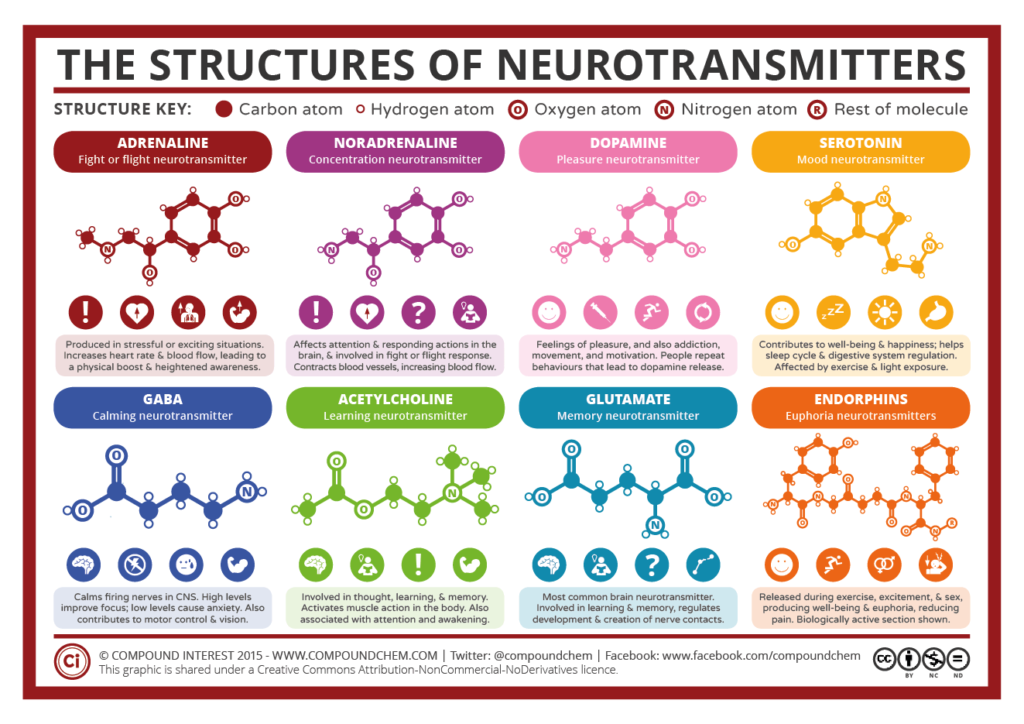Common Neurotransmitters
Dopamine
Norepinephrine & Epi
Endorphins
Serotonin
Oxytocin
Acetylcholine
Catecholamines are epinephrine (adrenaline), norepinephrine (noradrenaline), and dopamine.
END: Epi, NE, DA
GOES GA: GABA, Oxytocin, Endorphins, Serotonin; Glycine, Acetylcholine.
Neurotransmitters, Functions, and Related Diseases
| Neurotransmitter | Function in the brain | Diseases Related to these NT |
| Acetylcholine (ACh) | Involved in Thought, Learning, and Memory. | Alzheimer’s disease’ muscle movement in the PNS; Myasthenia Gravis |
| Dopamine (DA) (The Pleasure NT) |
Involved in reward circuits. Feelings of pleasure, and also addiction, movement, and motivation. People repeat behaviors that lead to dopamine release. |
Parkinson’s disease; Schizophrenia |
| Norepinephrine (NE) | Arousal | Depression |
| Serotonin | Depression; Aggression; Schizophrenia | |
| Glutamate (Glu) | Learning; Major excitatory NT in the brain | |
| GABA | Anxiety disorders; Epilepsy; Major inhibitory NT in the brain | |
| Endogenous Opioids (Endorphins, Enkephalins) |
Pain; Analgesia; Reward |
NT = Neurotransmitter.
In the brain, acetylcholine is involved in learning and memory. In the rest of the body, it stimulates muscle contractions. Medications with strong anticholinergic effects can have side effects like memory problems and confusion. These effects are more pronounced in older people. As such, medications with strong anticholinergic effects should be avoided in elderly patients.
Some SSRIs have stronger anticholinergic side effects than others, but in general they have a relatively low anticholinergic effect. Other newer antidepressants, including SNRIs such as venlafaxine and atypical antidepressants such as bupropion, have a very low anticholinergic effect.
Benzodiazepines bind to benzodiazepine receptors; enhances GABA effects.
Alcohol’s effects of ethanol in the CNS are mediated through GABA receptors.
Sedative-hypnotics (Zolpidem, Eszopiclone, Zaleplon) all interact with GABA-Benzodiazepine receptor complexes.
Drugs, Mechanism of Action, and Use
| Drug | Mechanism of Action | Use | Agonist / Antagonist |
| L-dopa | Increases synthesis of DA | Parkinson’s disease | Agonist for DA |
| Mixed amphetamine salts (Adderall) | Increase release of DA, NE | ADHD | Agonist for DA, NE |
| Ritalin (methylphenidate) | Blocks removal of DA, NE and lesser (5HT) from synapse | ADHD | Agonist for DA, NE mostly |
| Donepezil (Aricept) | Blocks removal of ACh from synapse | Alzheimer’s disease | Agonist for ACh |
| SSRI’s eg. Fluoxetine | Blocks removal of 5HT from synapse | Depression, OCD | Agonist 5HT |
| SNRIs e.g. duloxetine and venlafaxine | Block the reuptake of both serotonin and NE. | Depression, neuropathic pain. | |
| NDRIs e.g. Bupropion | Block reuptake of NE and DA from synapse | Tobacco cessation; Depression | |
| Quetiapine (Seroquel) | Blocks DA and 5HT receptors | Schizophrenia, Bipolar disorder | Antagonist for DA, 5HT |
| Naltrexone | Blocks opioid post-synaptic receptors | Alcoholism, opioid addiction | Antagonist for opioids |
Selective serotonin reuptake inhibitors (SSRIs)
Serotonin and norepinephrine reuptake inhibitors (SNRIs)
Norepinephrine and dopamine reuptake inhibitors (NDRIs)

Neurotransmitter Receptors That Are Ligand-Gated Ion Channels
| Functional Type | Ligand* | Ion Channel |
|---|---|---|
| Excitatory Receptors | ||
| Acetylcholine (nicotinic receptor) | Na+/K+ | |
| Glutamate (NMDA class receptors) | Na+/K+ and Ca2+ | |
| Glutamate (non-NMDA class receptors) | Na+/K+ | |
| Serotonin (5HT3 class receptors) | Na+/K+ | |
| Inhibitory Receptors | ||
| γ-Aminobutyric acid, GABA (A-class receptors) | Cl− | |
| Glycine | Cl− |
Some Neurotransmitter and Neuropeptide Receptors That Are Coupled to G Proteins
CLASSIC NEUROTRANSMITTERS
Acetylcholine* (muscarinic receptors)
GABA* (B-class receptors)
Adenosine
ATP
Dopamine
Epinephrine, norepinephrine
GABA* (B-class receptors)
Glutamate*
Histamine
Serotonin* (5HT1, 5HT2, 5HT4 receptors)
NEUROPEPTIDES
Adrenocorticotropic hormone (ACTH)
Bradykinin
Cholecystokinin (CCK)
Endothelin
Gastrin
Luteinizing hormone-releasing hormone (LHRH)
Opioids (e.g., β-endorphin)
Oxytocin
Tachykinins (e.g., substance P)
Thyrotropin-releasing hormone (TRH)
Vasoactive intestinal peptide (VIP)
Vasopressin
Reference
Lodish H, Berk A, Zipursky SL, et al. Molecular Cell Biology. 4th edition. New York: W. H. Freeman; 2000. Section 21.4, Neurotransmitters, Synapses, and Impulse Transmission. Available from: https://www.ncbi.nlm.nih.gov/books/NBK21521/
https://www.nimh.nih.gov/health/educational-resources/brain-basics/brain-basics.shtml

